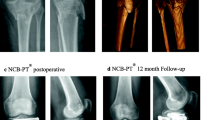Abstract
Purpose
Treatment of complex fractures of the distal femur utilizing monoaxial locking plates (e.g. Less Invasive Stabilisation System, LISS®, Synthes) is considered to be superior to conventional plating systems. Due to the limitation that the thread forces the screw into pre-determined positions, modifications have been made to allow screw positioning within a range of 30° (Non Contact Bridging, NCB®-DF, Zimmer). For the first time, this multicenter prospective randomized clinical trial (RCT) investigates the outcome of LISS® vs. NCB®-DF treatment following complex fractures of the distal femur.
Methods
Since June 2008, 27 patients with a fracture of the distal femur (AO ASIF 33-A-C and periprosthetic fractures) were enrolled in this study by four university trauma centres in southern Germany. Clinical (e.g. range of motion, Oxford knee score, Tegner score) and radiological (e.g. axis deviation, secondary loss of realignment) follow-ups were conducted one and six weeks, as well as three, six, and 12 months after the operation.
Results
This study comprises data of 27 patients (8 male, 19 female; 15 NCB®-DF, 12 LISS®). Polyaxial osteosynthesis using the NCB® system tended to result in better functional knee scores and a higher range of motion. Interestingly, fracture union tended to be more rapid using the polyaxial plating system.
Conclusions
We present the analysis of a multicenter prospective RCT to compare the monoaxial LISS® vs. the polyaxial NCB®-DF treatment following complex fractures of the distal femur. NCB®-DF treatment tended to result in better functional and radiological outcomes than LISS® treatment.
Level of Evidence
Level I



Similar content being viewed by others
References
Martinet O, Cordey J, Harder Y, Maier A, Buhler M, Barraud GE (2000) The epidemiology of fractures of the distal femur. Injury 31(Suppl 3):C62–C63
Schandelmaier P, Gossling T, Partenheimer A, Krettek C (2002) Distal fractures of the femur. Chirurg 73:1221–1233
Kinzl LF (2000) Distal. In: Ruedi TP, Murphy WM (eds) AO Principles of fracture management. Thieme, New York, pp 469–480
Partenheimer A, Gosling T, Muller M, Schirmer C, Kaab M, Matschke S, Ryf C, Renner N, Wiebking U, Krettek C (2007) Management of bicondylar fractures of the tibial plateau with unilateral fixed-angle plate fixation. Unfallchirurg 110:675–684
Kregor PJ, Stannard J, Zlowodzki M, Cole PA, Alonso J (2001) Distal femoral fracture fixation utilizing the Less Invasive Stabilization System (L.I.S.S.): the technique and early results. Injury 32(Suppl 3):SC32–SC47
Cole PA, Zlowodzki M, Kregor PJ (2003) Less Invasive Stabilization System (LISS) for fractures of the proximal tibia: indications, surgical technique and preliminary results of the UMC Clinical Trial. Injury 34(Suppl 1):A16–A29
Marti A, Fankhauser C, Frenk A, Cordey J, Gasser B (2001) Biomechanical evaluation of the less invasive stabilization system for the internal fixation of distal femur fractures. J Orthop Trauma 15:482–487
Chakravarthy J, Bansal R, Cooper J (2007) Locking plate osteosynthesis for Vancouver type B1 and type C periprosthetic fractures of femur: a report on 12 patients. Injury 38:725–733
Holzapfel BM, Prodinger PM, Hoberg M, Meffert R, Rudert M, Gradinger R (2010) Periprosthetic fractures after total hip arthroplasty: classification, diagnosis and therapy strategies. Orthopade 39:519–535
Otto RJ, Moed BR, Bledsoe JG (2009) Biomechanical comparison of polyaxial-type locking plates and a fixed-angle locking plate for internal fixation of distal femur fractures. J Orthop Trauma 23:645–652
El-Zayat BF, Zettl R, Efe T, Kruger A, Eisenberg F, Ruchholtz S (2012) Minimally invasive treatment of geriatric and osteoporotic femur fractures with polyaxial locking implants (NCB-DF(R)). Unfallchirurg 115:134–144
Hanschen M, Biberthaler P (2013) Mono- versus polyaxial locking plates. Unfallchirurg 116:733–741
Tegner Y, Lysholm J (1985) Rating systems in the evaluation of knee ligament injuries. Clin Orthop Relat Res 198:43–49
Whitehouse SL, Blom AW, Taylor AH, Pattison GT, Bannister GC (2005) The Oxford knee score; problems and pitfalls. Knee 12:287–291
Rasmussen PS (1973) Tibial condylar fractures. Impairment of knee joint stability as an indication for surgical treatment. J Bone Joint Surg Am 55:1331–1350
Sommer C, Babst R, Muller M, Hanson B (2004) Locking compression plate loosening and plate breakage: a report of four cases. J Orthop Trauma 18:571–577
Miranda MA (2007) Locking plate technology and its role in osteoporotic fractures. Injury 38(Suppl 3):S35–S39
Schutz M, Sudkamp NP (2003) Revolution in plate osteosynthesis: new internal fixator systems. J Orthop Sci 8:252–258
Luthi U, Rahn BA, Perren SM (1980) Area of contact between osteosynthesis plate and bone in internal fixation (author’s transl). Aktuelle Traumatol 10:131–136
Zettl R, Muller T, Topp T, Lewan U, Kruger A, Kuhne C, Ruchholtz S (2011) Monoaxial versus polyaxial locking systems: a biomechanical analysis of different locking systems for the fixation of proximal humeral fractures. Int Orthop 35:1245–1250
Ockert B, Braunstein V, Kirchhoff C, Korner M, Kirchhoff S, Kehr K, Mutschler W, Biberthaler P (2010) Monoaxial versus polyaxial screw insertion in angular stable plate fixation of proximal humeral fractures: radiographic analysis of a prospective randomized study. J Trauma 69:1545–1551
Konstantinidis L, Hauschild O, Beckmann NA, Hirschmuller A, Sudkamp NP, Helwig P (2010) Treatment of periprosthetic femoral fractures with two different minimal invasive angle-stable plates: biomechanical comparison studies on cadaveric bones. Injury 41:1256–1261
Roderer G, AbouElsoud M, Gebhard F, Claes L, Aschoff AJ, Kinzl L (2010) Biomechanical investigation of fixed-angle plate osteosynthesis of the proximal humerus. Unfallchirurg 113:133–138
Acknowledgments
The authors thank A. Berglehner, F. Gebhard, R. Meffert, and W. Mutschler for their valuable advice and support.
Conflict of interest
PB is a surgical instructor in AO courses on the LISS®-system as well as for the Zimmer institute on the NCB®-system. The entire study was independently conducted and did not receive any financial aid whatsoever.
Author information
Authors and Affiliations
Corresponding author
Rights and permissions
About this article
Cite this article
Hanschen, M., Aschenbrenner, I.M., Fehske, K. et al. Mono- versus polyaxial locking plates in distal femur fractures: a prospective randomized multicentre clinical trial. International Orthopaedics (SICOT) 38, 857–863 (2014). https://doi.org/10.1007/s00264-013-2210-0
Received:
Accepted:
Published:
Issue Date:
DOI: https://doi.org/10.1007/s00264-013-2210-0




